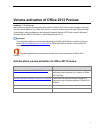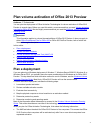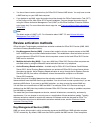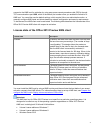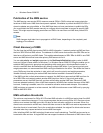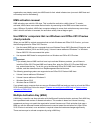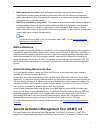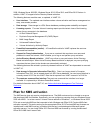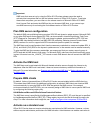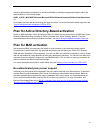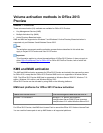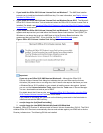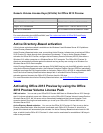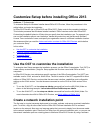
9
Important:
KMS hosts that were set up by using the Office 2013 Preview release cannot be used to
activate client computers that run the final release version of Office 2013 Preview. To activate
these client computers, you can either run the release version of Microsoft Office 2013 KMS
Host License Pack and enter the KMS host key on the same KMS host, or you can set up a
new KMS server only for activating the final release version of Office 2013 Preview.
Plan DNS server configuration
The default KMS auto-publishing feature requires SRV RR and dynamic update support. Microsoft DNS
or any other DNS server that supports SRV RRs, as documented in Internet Engineering Task Force
(IETF) Request for Comments (RFC) 2782, and dynamic updates, as documented in RFC 2136 can
support KMS client default behavior and KMS SRV RR publishing. Berkeley Internet Domain Name
(BIND) versions 8.x and 9.x support both SRV records and dynamic update, for example.
The KMS host must be configured so that it has the necessary credentials to create and update SRV, A
(IPv4), and AAAA (IPv6) RRs on the dynamic update servers, or the records must be created manually.
To give the KMS host the necessary credentials, we recommend that you create a security group in
AD DS and add all KMS hosts to that group. For Microsoft DNS, make sure that that this security group
is given full control over the _VLMCS._TCP record on each DNS domain that will contain the KMS SRV
RRs.
Activate the KMS host
The KMS host must be activated with Microsoft hosted activation servers through the Internet or by
telephone. After the KMS host is activated, it does not communicate any additional information to
Microsoft. For more information, see Prepare and configure the KMS host in Deploy volume activation
for Office 2010.
Prepare KMS clients
By default, Volume License editions of Office 2013 Preview are preinstalled with the KMS client key.
This makes them KMS clients. No additional configuration is required. KMS clients can locate a KMS
host automatically by querying DNS for SRV RRs that publish the KMS service. If the network
environment does not use SRV RRs, you can manually assign a KMS client to use a specific KMS host
by configuring the following registry key:
HKLM\Software\Microsoft\OfficeSoftwareProtectionPlatform
The KMS host name is specified by KeyManagementServiceName (REG_SZ), and the port is specified
by KeyManagementServicePort (REG_SZ). These registry keys can also be set through the ospp.vbs
script. For more information about ospp.vbs, see Tools to configure client computers in Office 2010.
Activate as a standard user
Office 2013 Preview does not require administrator permissions for KMS activation. However, volume
editions require administrator permissions for MAK activation. Administrators can enable users who do



